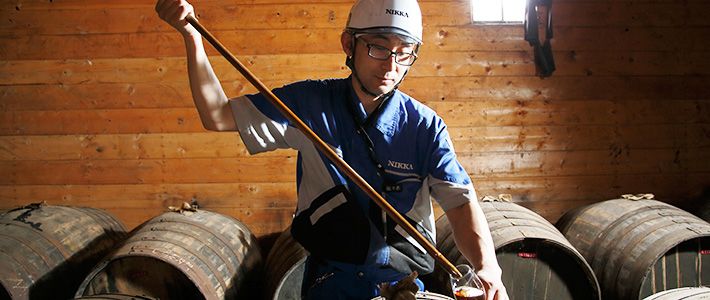
Japan Distills a World-Class Whisky Tradition
Guideto Japan
Culture Lifestyle- English
- 日本語
- 简体字
- 繁體字
- Français
- Español
- العربية
- Русский
The experience of savoring a glass of fine whisky is like entering into another world. The whisky lover is transported by the sight of the amber liquid and its rich, complex aroma intermingled with traces of the malt used to make the drink and hints of other ingredients.
How is it that a drink made with nothing more than barley and water can be cultivated to have such marvelously complex aromas and flavors? The answer comes down to a combination of the long aging process of up to 20 years or more after distillation, when natural flavors are picked up from casks storing the malt whisky, and the expertise of those tasked with overseeing the production process.
Japanese Whiskies Earn Global Respect
The British publication Whisky Magazine held its first “Best of the Best” contest in 2001, and Japanese distillers came away with the top two spots, as Suntory’s Hibiki 21-year-old placed second and Nikka’s Yoichi 10-year-old grabbed the first prize overall.
For the contest, 62 experts evaluated 47 whisky brands from Britain, the United States, and Japan. It was the first time for Japanese whisky to be recognized as among the world’s best, beating out renowned whiskies distilled in Scotland, the birthplace of the drink.
This year marks the 90th anniversary of the beginning of malt whisky production in Japan, which began in 1924 at the distillery of Kotobukiya (present-day Suntory Ltd.) located in the Yamazaki area outside Kyoto. As is clear from the table below, today’s Japanese whiskies proudly stand shoulder to shoulder with Scotch whiskies in terms of quality and flavor. We visited two distilleries in Japan to uncover the secrets behind their success.
Major Award-Winning Japanese Whiskies
| 2001 | WMA Best of the Best 1st prize | Nikka Single Cask Yoichi 10 Years Old |
|---|---|---|
| 2nd prize | Suntory Hibiki 21 Years Old | |
| 2007 | WWA World’s Best Blended Whisky | Suntory Hibiki 30 Years Old |
| WWA World’s Best Blended Malt Whisky | Nikka Taketsuru 21 Years Old | |
| 2008 | WWA World’s Best Blended Whisky | Suntory Hibiki 30 Years Old |
| WWA World’s Best Single Malt Whisky | Nikka Single Malt Yoichi 1987 | |
| 2009 | WWA World’s Best Blended Malt Whisky | Nikka Taketsuru 21 Years Old |
| 2010 | WWA World’s Best Blended Whisky | Suntory Hibiki 21 Years Old |
| WWA World’s Best Blended Malt Whisky | Nikka Taketsuru 21 Years Old | |
| 2011 | WWA World’s Best Blended Whisky | Suntory Hibiki 21 Years Old |
| WWA World’s Best Single Malt Whisky | Suntory Yamazaki 1984 | |
| WWA World’s Best Blended Malt Whisky | Nikka Taketsuru 21 Years Old | |
| 2012 | WWA World’s Best Single Malt Whisky | Suntory Yamazai 25 Years Old |
| WWA World’s Best Blended Malt Whisky | Nikka Taketsuru 17 Years Old | |
| 2013 | WWA World’s Best Blended Whisky | Suntory Hibiki 21 Years Old |
| WWA World’s Best Blended Malt Whisky | Mars Maltage 3 Plus 25, 28 Years Old | |
| 2014 | WWA World’s Best Blended Malt Whisky | Nikka Taketsuru 17 Years Old |
Note: “WM” is the abbreviation for Whisky Magazine and “WMA” stands for World Whiskies Awards
 Nikka Single Cask Yoichi 10 Years Old (left); Suntory Hibiki 21 Years Old (center); Nikka Taketsuru 21 Years Old (right)
Nikka Single Cask Yoichi 10 Years Old (left); Suntory Hibiki 21 Years Old (center); Nikka Taketsuru 21 Years Old (right)
80-year-old Yoichi Distillery Untouched by Time
An hour’s train ride from Sapporo, at the base of the Shakotan Peninsula, is Yoichi—a town of roughly 20,000 inhabitants that is a center of apple, cherry, and other fruit production. Near Yoichi’s train station, on the other side of a magnificent stone gate, is the Nikka distillery that has given birth to the malt whisky voted the world’s best in 2001. The distillery buildings look the same as they did when they first opened, 80 years earlier.
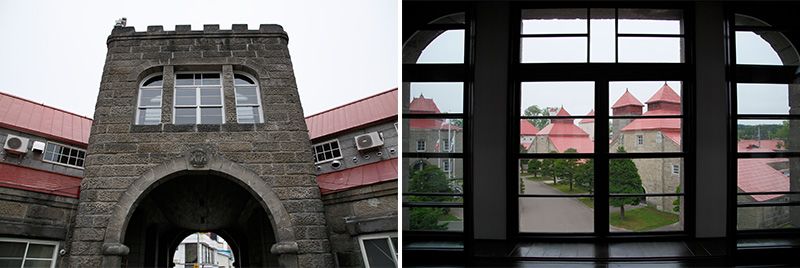 Stone gate entrance to Nikka’s Yoichi distillery. (left); View of the distillery from the second-floor window of the stone gate. (right)
Stone gate entrance to Nikka’s Yoichi distillery. (left); View of the distillery from the second-floor window of the stone gate. (right)
At the distillery we meet the head of operations, Sugimoto Jun’ichi, who tells us more about how Nikka Single Cask Yoichi earned the top prize from Whisky Magazine in 2001:
 Sugimoto Jun’ichi, the head of the Yoichi distillery.
Sugimoto Jun’ichi, the head of the Yoichi distillery.
“That ten-year-old whisky was aged in new casks. We undertook the challenge of doing that in the hope of creating a rich, full-bodied whisky. We evaluated the whisky after three or four years and knew we were on the right track and had chosen casks that perfectly suited the sort of flavor we were seeking.”
For most malt whiskies, distillers use casks that were formerly used to age bourbon whiskey or sherry, rather than new ones whose strong wood fragrance could overwhelm the delicate flavors of the distilled drink. The general view is that it is hard to master the use of new casks.
“There certainly was a risk involved,” Sugimoto notes, “but we made adjustments in terms of how we burned the inside of the casks and other things.” Apparently, the success Nikka achieved has even encouraged some distillers in Scotland to try their hand at using new casks.
Age-old Distilling Methods
Yoichi malt whisky has won praise for its rich, full-bodied flavor. What has made this possible was the use of what seems to be the world’s last remaining coal-fired pot still.
Distillation is the final process to extract the undiluted whisky from the fermented “wash.” And the pot still is the heart and soul of the Yoichi distillery. The person running the still constantly monitors its temperature. Every 10 minutes or so, he rapidly shovels in more coal to fuel it. The top of each still is adorned with a decorative rope, like those placed on sake barrels—a reference to the background of the distillery’s founder, Taketsuru Masataka (1894–1979), who was born into a family of sake brewers.
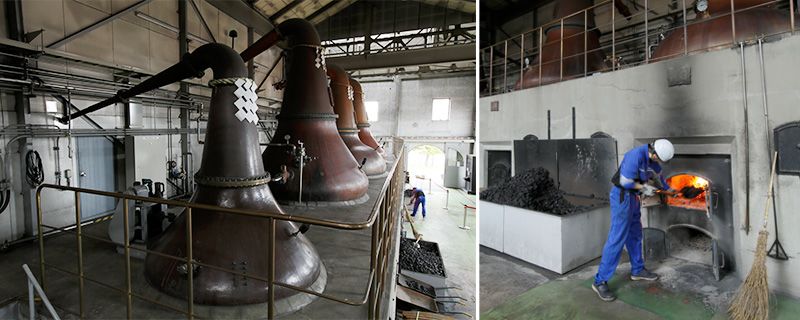 Pot stills at the Yoichi distillery. (left); A distillery worker shovels coal into a pot still. (right)
Pot stills at the Yoichi distillery. (left); A distillery worker shovels coal into a pot still. (right)
Nikka uses age-old techniques to run its pot stills; not only is it hard physical work, but adjusting the level of heat is also a challenge. “It’s not something that can be proven scientifically,” Sugimoto explains, “but the fluctuations in the heat of the coal fire seem to have a complex effect on the whisky produced. Using the same pot stills from the time of our founding has allowed us to create whisky that is distinctive to Yoichi. So we’re not likely to change this traditional approach in the years ahead.”
A Site Well-Suited to Whisky
Taketsuru Masataka decided to set up his distillery in Yoichi after searching for a place in Japan as similar as possible to the cool, damp climate of Scotland. The distillery opened in 1934, but for its first few years of operations the facility also produced apple juice and wine to support the business during the minimum three-to-five-year wait it took for the first batch of whisky to be ready for market.
Taketsuru believed that natural surroundings and climate are what lend a whisky its distinctive character, and this belief is apparent to anyone who visits the cask warehouse at the Yoichi Distillery. Its earthen floor and two-level arrangement of casks are unchanged from the first days of the distillery, and the simply designed building is circled by Japanese butterbur plants native to the area.
 The cask warehouse at the Yoichi Distillery.
The cask warehouse at the Yoichi Distillery.
During the long aging process in the Yoichi distillery’s cask warehouse, the stored whisky comes into contact with outside air seeping through the casks. “The ocean is just 900 meters away,” Sugimoto explains. And he believes that the sea breezes reaching the warehouse impact the flavor of the whisky in various ways.
Background to Japan’s First Whisky Production
 Taketsuru Masataka and his wife Rita.
Taketsuru Masataka and his wife Rita.
The history of whisky production in Japan can be traced back to 1918, the year that Taketsuru was sent to Scotland for his job by Settsu Shuzō, a company with plans to domestically produce whisky. At the time, the only “whisky” produced in Japan was an imitation drink made by adding flavors and fragrances to rectified spirits.
Taketsuru studied chemistry at the University of Glasgow and also learned first-hand about whisky production by apprenticing at the Longmorn (today’s Glenlivet) in Speyside and the former Hazelburn distillery in Campbeltown.
But Taketsuru returned to Japan in 1920 to find that the company Settsu Shuzō was having second thoughts about its plan to produce an authentic Scotch whisky in Japan because of the economic recession gripping the nation after the end of World War I.
Taketsuru ended up being hired away by Torii Shinjirō (1879–1962), an entrepreneur keen to embark on whisky production. Torii was inspired to invest in that new business based on the popularity at his Torii Shōten store of Akadama Port Wine, a sweet imported red wine suited to Japanese tastes. The success of the store led Torii to found the company Kotobukiya in 1921.
The two men teamed up to create Japan’s first domestically produced whisky in 1929, Suntory Shirofuda (White Label). Five years later, though, Taketsuru parted ways with Torii to set up his own operation.
Torii went on to launch one of Japan’s longest selling whiskies, Suntory Kakubin, in 1937, while Takutsuru unveiled his first product, Nikka Whisky, in 1940. Not long after, though, whisky production came under controls initiated during World War II. But one bright spot for the industry during this time was that the key ingredients for whiskey could still be obtained, allowing whisky production to continue.
 Japan’s first whisky, Suntory Shirofuda (left); original bottle of Suntory Kakubin (center); Nikka’s first whisky (right).
Japan’s first whisky, Suntory Shirofuda (left); original bottle of Suntory Kakubin (center); Nikka’s first whisky (right).
Historical Highlights of Whisky in Japan
| 1853 | Commodore Matthew Perry and his US Navy fleet arrive in Japan, giving the Japanese what may have been their first contact with whisky |
|---|---|
| Circa 1870 | Imports of whisky for Japanese begin |
| 1902 | Anglo-Japanese Alliance is signed; following the agreement, imports of whisky from the West increase |
| 1918 | Taketsuru Masataka is dispatched by the company Settsu Shuzo to Scotland to research whisky production (returns to Japan in 1920) |
| 1923 | The owner of Kotobukiya (today’s Suntory Ltd.) begins planning domestic whisky production and hires Taketsuru toward that end |
| 1924 | Production begins at Kotobukiya’s Yamazaki distillery |
| 1929 | Sales begin of first domestic whisky, Suntory Shirofuda (White Label) |
| 1934 | Taketsuru leaves Kotobukya and establishes his own company, Dai Nippon Kajū (today’s Nikka Whisky Distilling Co., Ltd.) |
| 1937 | Suntory begins sales of Kakubin |
| 1940 | Nikka begins sales of its first whisky |
| Circa 1955 | Whisky bars begin opening up in major urban areas, sparking a boom in highballs |
| 1964 | Asahi Breweries Ltd., which has close ties with Nikka, begins production of Japan’s first authentic grain whisky |
| 1969 | Nikka opens the Miyagikyō distillery as its second production site |
| 1971 | Tariffs reduced on imports of Western alcoholic beverages |
| 1973 | Suntory opens its Hakushū distillery as its second production site |
| Kirin Seagram Ltd. (today’s Kirin Distillery Co., Ltd.) opens its Fuji Gotenba distillery and begins sales the following year of Robert Brown whisky | |
| 1983 | Whisky market peaks out; sales of most whiskies decline from the following year up to 2008 |
| 1989 | Suntory begins sales of Hibiki |
| 2000 | Nikka begins sales of Taketsuru |
Postwar Whisky Boom
 Suntory’s Hakushū distillery in Hokuto, Yamanashi prefecture; photograph courtesy of Suntory Ltd.
Suntory’s Hakushū distillery in Hokuto, Yamanashi prefecture; photograph courtesy of Suntory Ltd.
Around the middle of the 1950s Japanese society began to get back on track following the devastation of World War II, and this recovery coincided with a boom in Western alcoholic beverages. Japanese sake, which had been the mainstay drink up to then, began to be overshadowed by rising demand in large cities for beer and whisky. By around 1964, as the nation was enjoying powerful economic growth, Japan began to distill grain whisky (made from corn and other types of grain and distilled in a continuous column still), which is essential to the production of blended whiskey. Production capacity for malt whiskies was also expanded, as Nikka opened its Miyagikyō distillery in 1969 and Suntory established its Hakushū distillery in 1973—the second distillery for each company.
Scotland is home to over 100 malt whisky distilleries, each producing highly individual whiskies. It has been the custom for these distilleries to exchange or sell their malt whiskies with each other to get hold of whiskies of a different type than their own. And blenders like Johnny Walker and Ballantine have in some cases combined over 40 types of different whiskies to create blended Scotch whiskies of marvelous complexity in flavor and aroma.

Producing a Wider Range of Malt Whiskies
Japan did not have that system for blending whisky in place, however. This meant that each distiller had to produce a variety of types of malt whisky for their own blends. Both of the main distilling companies, Suntory and Nikka, had to open a second distillery not only to increase that quantity of malt whisky produced but also to expand the variety of whiskies produced, thereby raising the level of quality.
Japanese whisky would never have reached its world-class level of today if it hadn’t been for the rising demand during the postwar economic boom years that led those two companies to take the proactive measure of opening up new distilleries.
 Nikka’s chief blender, Sakuma Tadashi, explains more about the unique qualities of the company’s two distilleries. “The natural surroundings and climate of our Miyagikyō distillery [in Sendai, Miyagi Prefecture] as well as its production facilities and equipment are quite different from the situation at our Yoichi distillery. Our aim in opening a second distillery was clear. Namely, we wanted to create a smoother and lighter malt whisky than the more robust flavor of our Yoichi whiskies.”
Nikka’s chief blender, Sakuma Tadashi, explains more about the unique qualities of the company’s two distilleries. “The natural surroundings and climate of our Miyagikyō distillery [in Sendai, Miyagi Prefecture] as well as its production facilities and equipment are quite different from the situation at our Yoichi distillery. Our aim in opening a second distillery was clear. Namely, we wanted to create a smoother and lighter malt whisky than the more robust flavor of our Yoichi whiskies.”
Suntory’s two distilleries are also in contrasting locations. The Yamazaki distillery was established in an area near Osaka famed for its mineral water, while the Hakushū distillery was built at an altitude of 700 meters in a forest located in Hokuto, Yamanashi Prefecture, near Japan’s Southern Alps. The two distilleries have been able to create over 100 types of different whiskies between them by varying the ingredients used and making small changes in the production process.
Whisky Market Dries Up in the 80s
The smooth-sailing whisky industry in Japan hit a rough patch in the 1980s. Annual production peaked in 1983 at 379,000 kiloliters, and declined in almost every year that followed until 2008, due to the decline in demand. At the end of that 25-year period, whisky consumption was only one-fifth of what it had been at its peak.
The reasons for the decline of Japanese whisky included not only an increase in the tax on whisky introduced in 1984, but also a diversification of consumer tastes as wine consumption began to rise and more Japanese took to mixing the distilled liqueur shōchū with carbonated drinks. Another factor was the significant lowering of the tariff placed on imported whisky. The combination of these factors led to the closure of some domestic whisky producers, including the shuttering of Mercian Wine Company’s Karuizawa distillery.
Highball Boom Lifts Whisky Market
But in 2009 the Japanese whisky market finally started to flow again, and sales increased in each of the five subsequent years to 2014. This turnaround owed much to Suntory’s highball campaign that brought whisky to the attention of a younger generation of drinkers.
Amid the highball boom, Suntory’s Single Malt Hakushū has also enjoyed popularity, promising consumers the “invigorating aroma of a forest,” as the head of the distillery, Ono Takeshi, explains: “Our no-age-statement whisky evokes the smell of young leaves, while our 12-year-old is reminiscent of fresh greenery. Our 18-year-old single malt, meanwhile, has a fruity flavor, and the Hakushū single malt that we age for 25 years is like a rich jam.”
 Ono Takeshi, head of the Hakushū distillery. (left); Suntory Single Malt Hakushū 12 Years Old. (right)
Ono Takeshi, head of the Hakushū distillery. (left); Suntory Single Malt Hakushū 12 Years Old. (right)
Suntory Takes a Fresh Look at its Whisky Production
Ono joined Suntory in 1989. He became involved in whisky production as a technician and blender at the time when Japanese whisky’s popularity was in decline. Around 1990, Suntory launched a company-wide project to rethink its whisky production from square one by bringing a scientific approach to bear on the experience- and intuition-based methods that its technicians had relied on up to then.
Simply put, the process of making a malt whisky involves, first of all, germinating two-rowed barley to create malt, which is then smoked over a peat fire. In the second stage, this malt is mashed by crushing it and adding hot water, and then slowly heated to convert the starch into sugars. The “wort” that results is extracted and placed in a fermenting vat, and yeast is added to it. And after about 70 hours, this fermented liquid, or “wash,” has an alcohol content of 6 to 7%.
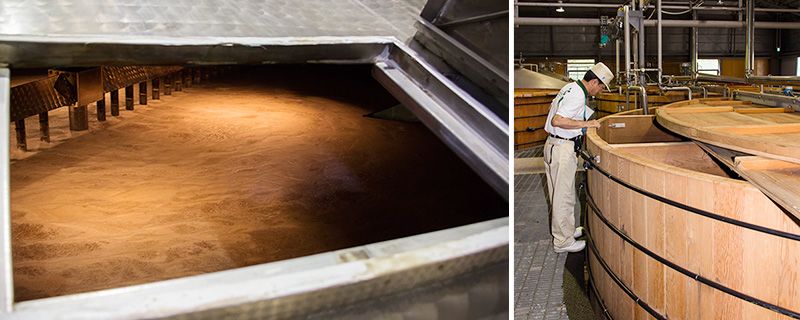 The vat used to create the “wort” (left); the wooden fermenting vat at the Hakushū distillery (right).
The vat used to create the “wort” (left); the wooden fermenting vat at the Hakushū distillery (right).
The liquid is passed through a pot still two separate times to create a colorless alcohol called “new pot” that has an alcohol percentage of around 70%. This is the fourth stage of the process. Water is added to the new pot to get the percentage down to around 60%, and this is then aged in casks for at least 3 years—although more often for 5, 10, or 15 years.
 Ono explains more about the nature of the project: “If you take the fermentation process, for example, it includes the phases of growth, ripening, and then a withering away. We tried to look, scientifically, at the best point at which to extract the components. Based on this sort of approach we also learned that if the froth produced at the beginning of the fermentation process is kept at a certain height it will make it possible to extract the ‘umami’ elements. In doing this, we were able to evaluate the umami elements by measuring the level of change in a particular amino acid within the wort. These are some examples of the sort of scientific measures we’ve been implementing.”
Ono explains more about the nature of the project: “If you take the fermentation process, for example, it includes the phases of growth, ripening, and then a withering away. We tried to look, scientifically, at the best point at which to extract the components. Based on this sort of approach we also learned that if the froth produced at the beginning of the fermentation process is kept at a certain height it will make it possible to extract the ‘umami’ elements. In doing this, we were able to evaluate the umami elements by measuring the level of change in a particular amino acid within the wort. These are some examples of the sort of scientific measures we’ve been implementing.”
 Foam on the wort as fermentation progresses.
Foam on the wort as fermentation progresses.
“That was a period that followed the great boom period for whisky,” Ono recalls. “We realized that the old approach would no longer work, and that we would need to come up with something better. Suntory began sales of its Single Malt Yamazaki in 1984, but we knew that in the future we would have to come up with more distinctive malt whiskies, and that this would also require a change in our marketing approach.”
Ono also points out that, when it comes to making whisky, you can’t just simply follow the recipe. “Differences in temperature or humidity at the time of preparing the barley and fermentation require different approaches. It takes a long time for a distillery to develop the know-how and capacity for fine-tuning needed to respond to these differences. Our distillery here has been open for 33 years, but it took us quite a while to get to the level we are at now.”
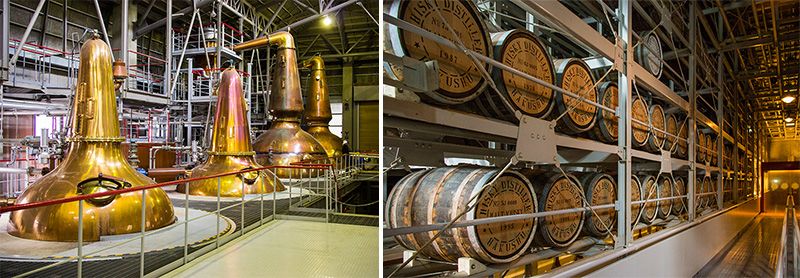 Pot stills of various shapes at the Hakshū distillery. (left); Cask warehouse at the Hakushū distillery. (right)
Pot stills of various shapes at the Hakshū distillery. (left); Cask warehouse at the Hakushū distillery. (right)
Nikka Produces a World-class Single Malt
Nikka, Suntory’s rival, also launched a concerted effort in the 1980s to raise the quality of its lineup, aiming to create world-class whiskies. This effort was spurred by the company’s concerns about the increasingly fierce competition from foreign distilleries as Japanese tariffs on foreign alcohol continued to fall.
Sakuma Tadashi, the chief blender at Nikka’s Yoichi distillery, joined the company in 1982. “At the time,” he recalls, “the company gathered together all of its technicians to experiment with various things. We started by taking a fresh look at our ingredients, the types of yeast used for fermentation, and our casks, and this led us to make quite a lot of changes in our production approach—from the malting stage up to distillation.”
 Nikka’s chief blender, Sakuma Tadashi (left).
Nikka’s chief blender, Sakuma Tadashi (left).
The company’s efforts bore fruit 20 years later when its Single Malt Yoichi 1987 won the World Whiskies Awards’ “Best Single Malt” prize for 2008, marking the first time for a Japanese single malt to capture the world’s top prize.
“Winning that award was the culmination of everything we had been aiming for, and there was nothing haphazard about that achievement,” Sakuma says with pride. “In the years since we have won many more awards, and this success was built on the technical efforts we began making back in the 1980s.”
In 1968, the founder of Nikka, Taketsuru Masataka, looked back on his professional life in a set of serialized articles for Nikkei Shimbun. In describing his hands-on apprenticeship at distilleries in Scotland he wrote that, “The wonderful aromas and deep-rooted traditions that I encountered back then shine through even today . . . But it proved very difficult to create those aromas ourselves in Japan.”
The industry has come a long way since those days, however, as demonstrated by the high praise Japanese whiskies are now earning.

Contrasting Outlooks of Nikka and Suntory
In recent years, Suntory has been winning top prizes in global contests for its blended whisky Hibiki and its Yamazaki single malt, just as Nikka has been doing for its blended pure malt Taketsuru. But, interestingly, the two companies hold quite different opinions when it comes to the question of how—if at all—Japanese whisky differs from Scotch whisky.
For Nikka, the ideal is to create whisky that is an extension of the original Scotch tradition. “There is no essential difference between our whisky and Scotch,” chief blender Sakuma asserts. “We don’t want to place too much emphasis on the fact that our whisky is produced in Japan.”
“Basically we are producing whisky that speaks the ‘same language’ as Scotch, although their accents might be a bit different. If you pour out a hundred glasses of Nikka whisky and Scotch whisky, I think you’d find it hard to identify which ones were Japanese and which ones weren’t.”
Suntory, for its part, emphasizes how its whiskies differ in character from Scotch whisky. The company, which has a leading share of the Western spirits market in Japan, has sought to create products that are well suited to Japanese cuisine and culinary tastes.
“Scotch is a drink born of the climate and landscape of Scotland, “says the head of the Hakushū distillery, Ono, “whereas our Japanese whisky is fostered by the four seasons of Japan.”
“Japan has a much more favorable climate than Scotland in terms of aging whisky because of our more temperate climate, and this lends Japanese whisky its distinctive qualities. On top of this, we have cultivated whiskies that suit the well-balanced and smooth flavors favored by the Japanese palate. And now these flavors also seem to be winning over whisky lovers around the world.”
(Originally written in Japanese by Ishii Masato, an editor at Nipppon.com; photographs of the Nikka Yoichi distillery by Yamada Shinji. Banner photograph is a June, 20, 2014, image of a technician at Nikka’s Yoichi distillery extracting a whisky sample to gauge the maturation process.)
tourism Hokkaidō Suntory whisky Scotland Nikka Taketsuru Masataka Whisky Magazine World Whiskies Awards WWA Yoichi Hakushū Yamazaki Miyagikyō Torii Shinjirō